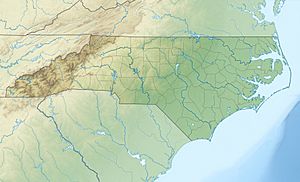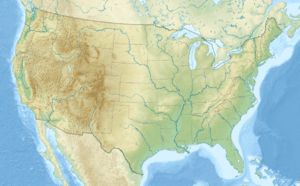Mill Run (Trent River tributary) facts for kids
Quick facts for kids Mill Run |
|
|---|---|
|
Location of Mill Run mouth
|
|
| Other name(s) | Tributary to Trent River |
| Country | United States |
| State | North Carolina |
| County | Jones |
| Physical characteristics | |
| Main source | Crooked Run divide about 1 mile southwest of Olivers Crossroads, North Carolina 40 ft (12 m) 35°00′24″N 077°19′57″W / 35.00667°N 77.33250°W |
| River mouth | Trent River about 2 mile southeast of Olivers Crossroads, North Carolina 3 ft (0.91 m) 35°00′44″N 077°16′25″W / 35.01222°N 77.27361°W |
| Length | 3.52 mi (5.66 km) |
| Basin features | |
| Progression | generally northeast |
| River system | Neuse River |
| Basin size | 11.84 square miles (30.7 km2) |
| Tributaries |
|
| Bridges | Olivers Cross Road, Davis Field Road, NC 58 |
Mill Run is a small stream, about 3.52 mi (5.66 km) long, located in Jones County, North Carolina. It's a "tributary," which means it's a smaller stream that flows into a larger river. Mill Run flows into the Trent River.
About Mill Run
Mill Run is considered a "2nd order tributary." Think of it like this: tiny streams that don't have other streams flowing into them are 1st order. When two 1st order streams join, they form a 2nd order stream, like Mill Run. This system helps organize how we understand rivers.
Where Does it Start and Go?
Mill Run begins its journey about 1 mile southwest of a place called Olivers Crossroads in North Carolina. This starting point is called its "source." From there, the stream flows generally towards the northeast.
After its journey, Mill Run joins the Trent River. This meeting point is called its "mouth." The mouth of Mill Run is located about 1 mile southeast of Olivers Crossroads.
What's Around Mill Run?
The area of land that drains water into Mill Run is called its "watershed" or "basin." Imagine all the rain that falls on this land eventually flowing into Mill Run. This watershed covers about 11.84 square miles (30.7 km2).
The area around Mill Run gets a good amount of rain each year, about 54.0 inches. A large part of its watershed, about 18%, is covered by forests. These forests are important because trees help keep the water clean by filtering out pollutants and preventing soil from washing into the stream.
Mill Run is part of a larger river system that eventually flows into the Neuse River. This means that the water from Mill Run travels through the Trent River and then into the Neuse River before reaching the ocean.



